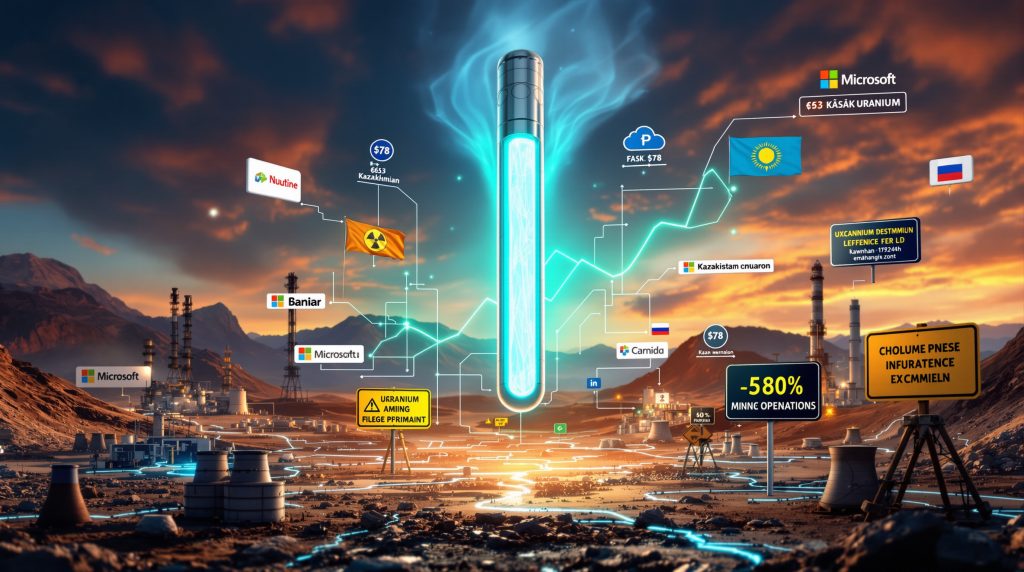The Uranium Supply Shock: Market Dynamics and Investment Implications
The global uranium market is experiencing significant supply disruptions that have created compelling investment fundamentals. With simultaneous production cuts in Kazakhstan and political instability in Niger threatening nearly half of the world's uranium output, market dynamics have shifted dramatically. This uranium market volatility combined with emerging demand from AI applications and supportive government policies, has established a structural imbalance that uranium investors are actively capitalizing on.
What Is Causing the Current Uranium Supply Shock?
The global uranium market is facing a significant supply disruption due to simultaneous production issues in key uranium-producing regions. Kazakhstan, responsible for approximately 43% of global uranium production, has implemented a 20% production cut through its national atomic company Kazatomprom, reducing output to a mid-point guidance of 14 million pounds. Concurrently, political instability in Niger threatens operations at Orano's SOMAIR mine, which contributes roughly 5% of global supply.
This dual uranium supply shock affects nearly half of the world's uranium production capacity, creating immediate supply constraints in an already tight market. The situation is particularly impactful because uranium production is highly concentrated, with the top five producing countries controlling approximately 75% of global supply.
The timing of these disruptions is especially problematic as historical secondary sources of uranium supply, such as decommissioned weapons and utility stockpiles, have significantly diminished in recent years. These secondary sources once provided a crucial buffer against production shortfalls but are no longer available in sufficient quantities to mitigate current supply constraints.
How Does Market Structure Amplify the Supply Shock?
Concentrated Production Base
The uranium market's vulnerability stems from its extreme concentration. Kazakhstan, Canada, Australia, Namibia, and Uzbekistan collectively account for three-quarters of global production. This concentration means that disruptions in even one major producing region can significantly impact global supply dynamics.
The limited number of active uranium mines worldwide creates structural supply inelasticity, as developing new projects requires extensive permitting processes and substantial capital investments. Industry experts note that bringing new uranium mines online typically requires 7-10 years from discovery to production, meaning that current supply disruptions cannot be quickly resolved through alternative sources.
Limited Trading Volume
The uranium market operates with remarkably thin trading volumes compared to demand. Annual spot market transactions typically range between 15-20 million pounds, representing only about 10% of the 190+ million pounds required annually by global reactors. This limited liquidity means that even modest changes in buying patterns can dramatically influence pricing.
Most uranium transactions occur through long-term contracts rather than spot purchases, with utilities typically securing supply 18-24 months in advance due to conversion and enrichment processing requirements. This procurement timeline creates pressure when supply disruptions occur, as utilities cannot quickly substitute alternative sources.
Declining Secondary Supply
Secondary uranium sources, which once provided significant market buffer, have steadily declined:
| Secondary Supply Source | Historical Peak (Annual) | Current Level (Annual) | Percentage Decline |
|---|---|---|---|
| Decommissioned Weapons | 15 million pounds | < 3 million pounds | 80% |
| Utility Stockpiles | 9 million pounds | < 4 million pounds | 56% |
| Total Secondary Supply | 24 million pounds | < 7 million pounds | 71% |
This reduction places greater reliance on primary production at precisely the moment when major producers are experiencing disruptions.
The Megatons to Megawatts program, which converted highly enriched uranium from Russian warheads into reactor fuel, ended in 2013, removing approximately 24 million pounds of annual secondary supply. This program previously supplied roughly 13% of global nuclear fuel requirements but is no longer available to offset production shortfalls.
What Price Movements Have Resulted From the Supply Shock?
The uranium market has demonstrated remarkable resilience despite broader commodity market volatility. After reaching March 2025 lows of approximately $63.50 per pound, spot prices recovered to $78.56 by June 2025, representing a 24% increase over three months. This recovery occurred during a period when many other commodity markets struggled with demand concerns.
The UxC weekly spot price indicator shows uranium has outperformed most base metals during 2025, with copper declining 8% and zinc falling 12% over the same period when uranium gained 24%. This divergence highlights uranium's distinct market dynamics and the impact of supply constraints on pricing.
Long-term contract pricing has stabilized in the $80-89 per pound range, providing revenue visibility for producers and indicating utility willingness to secure supply at higher price levels. The differential between spot and term pricing reflects market expectations of continued supply tightness.
Market analysts emphasize that the price recovery reflects fundamental supply-demand tightness rather than speculative activity. Historical analysis shows that uranium price cycles typically last 8-12 years, with the previous cycle peaking at $140 per pound in 2007 before declining to sub-$20 levels by 2016. The current price recovery from 2020 lows of $24 per pound represents the early stages of a new cycle driven by supply constraints and improving demand fundamentals.
How Are New Demand Vectors Influencing the Market?
Data Center and AI Power Requirements
Nuclear energy's role in supporting artificial intelligence and data center applications creates new demand vectors beyond traditional electricity generation. Data center electricity consumption is projected to grow 15-20% annually, driving baseload power demand that aligns perfectly with nuclear energy's consistent generation profile.
Microsoft's 20-year partnership with Constellation Energy to restart Three Mile Island Unit 1 demonstrates corporate commitment to nuclear power for AI applications. This agreement represents a new model where technology companies directly support nuclear generation to power data centers with carbon-free electricity.
The technical specifications for AI workloads require consistent power supply with minimal interruption, making nuclear energy's 90%+ capacity factor attractive compared to renewable sources with intermittency challenges. Google has similarly partnered with Kairos Power to develop 500 MW of SMR capacity by 2035, with the first reactor expected online by 2030.
Corporate Clean Energy Procurement
Major corporations increasingly seek carbon-free electricity sources for ESG commitments. Nuclear energy's reliable, emissions-free generation profile makes it attractive for companies pursuing net-zero targets. This corporate procurement trend creates demand that operates independently from traditional utility purchasing patterns.
Amazon has committed to supporting SMR development through investments in X-energy and agreements to purchase power from multiple SMR projects. These corporate partnerships represent approximately $10 billion in committed investment in advanced nuclear technologies.
Advanced Reactor Development
Technological innovations in nuclear reactor design are expanding potential applications. Small modular reactors (SMRs) and microreactors create flexibility for deployment in locations previously unsuitable for nuclear generation. These technologies typically require higher-enriched fuel, potentially increasing uranium demand per megawatt of capacity.
High Assay Low Enriched Uranium (HALEU) fuel required by advanced reactors contains 5-20% uranium-235, compared to 3-5% for conventional reactors, potentially increasing uranium feedstock requirements. The development of next-generation reactor technologies represents both a shift in uranium demand patterns and potential increases in total consumption.
What Policy Developments Support Nuclear Energy Growth?
U.S. Domestic Production Initiatives
The U.S. government has implemented policies to expand domestic US uranium production and enrichment capacity, addressing strategic supply chain vulnerabilities. The ban on Russian uranium imports beginning January 2028, with limited waivers until 2035, creates structural demand for alternative supply sources.
Russia supplied approximately 24% of U.S. uranium imports in 2023, representing roughly 12.2 million pounds of uranium. The U.S. government has allocated $2.2 billion for domestic uranium enrichment capacity expansion to ensure fuel security for the country's 93 operating reactors.
Centrus Energy's agreement with Korea Hydro & Nuclear Power (KHNP) and POSCO International demonstrates international collaboration to increase enriched uranium supply. Korea represents one of the largest potential export markets for U.S. enriched uranium, with 26 operating reactors where KHNP serves as the world's third-largest nuclear plant operator.
India's Market Liberalization
India has ended its longstanding state monopoly on uranium activities, allowing private firms to engage in uranium mining, imports, and processing. This policy change accepts foreign minority investment up to 49% to support nuclear expansion objectives, potentially opening one of the world's fastest-growing energy markets to uranium investment.
India's nuclear capacity is planned to increase from current levels of 7 GW to 22.8 GW by 2031, requiring significant uranium supply increases. This policy shift represents one of the most significant changes in global nuclear energy development, potentially creating new demand centers for uranium producers.
World Bank Financing Support
The World Bank's decision to finance nuclear projects marks a fundamental shift from historical reluctance to support nuclear energy development. This policy change could significantly impact global capital flows and reduce financing costs for nuclear power projects in developing economies.
The reversal of a 32-year policy of excluding nuclear energy from development financing opens new pathways for nuclear deployment in emerging markets. This institutional support signals broader acceptance of nuclear energy's role in addressing climate change while meeting growing energy demand in developing nations.
How Are Companies Raising Capital for Uranium Projects?
The improved uranium market conditions have enabled companies to secure funding through various mechanisms:
| Company | Financing Amount | Structure | Purpose |
|---|---|---|---|
| Standard Uranium | C$3.5 million | Private placement with flow-through shares | Davidson River exploration program |
| North Shore | C$1.4 million | Oversubscribed private placement | Rio Puerco project acquisition |
| Purepoint Uranium | C$6 million | Flow-through financing (three tranches) | Athabasca Basin exploration |
| Laramide Resources | C$12 million | 20 million common shares at C$0.60 | U.S. permitting advancement |
These transactions reveal several key trends in uranium sector capital allocation:
-
Flow-through structures provide tax advantages that justify premium pricing, with Saskatchewan flow-through shares commanding the highest premiums due to enhanced provincial tax benefits that can provide total tax savings of up to 47.5% for high-income investors.
-
The oversubscribed nature of several offerings indicates improving investor sentiment toward uranium exploration projects in established mining jurisdictions.
-
Warrant structures provide upside participation while extending companies' financial runway through potential future exercises, typically offering 24-36 month exercise periods at premiums of 50-100% to current share prices.
-
Partnership strategies, exemplified by Standard Uranium's technology collaborations, represent efficient capital allocation approaches that reduce direct funding requirements while maintaining significant project exposure.
Flow-through financing in the uranium sector totaled approximately C$180 million in 2024, representing a 340% increase from 2023 levels. This surge in capital availability reflects institutional confidence in uranium market fundamentals and recognition of the sector's growth potential.
What Physical Uranium Investment Vehicles Exist?
Physical uranium funds have emerged as significant market participants, effectively removing substantial quantities from available supply:
- Sprott Physical Uranium Trust has accumulated over 56 million pounds since 2021
- The trust recently raised an oversubscribed $200 million to purchase additional uranium
- Collectively, physical funds now hold over 60 million pounds of uranium
These investment vehicles provide exposure to physical uranium price movements without operational risks associated with mining companies. Their continued accumulation reduces available spot market supply, potentially supporting higher prices.
Physical uranium storage requires specialized facilities licensed for radioactive material handling, with storage costs typically ranging $0.30-0.50 per pound annually. Uranium stored in investment vehicles must meet specific purity standards and be held at approved facilities to maintain market acceptability.
Yellow Cake plc represents another significant physical uranium investment vehicle, holding approximately 17.2 million pounds of uranium stored at facilities in Canada and France. The Global X Uranium ETF (URA) has attracted over $2.8 billion in assets under management, providing exposure to uranium mining companies rather than physical uranium.
How Are Producers Performing Financially?
Leading uranium companies have demonstrated strong operational and financial performance:
- Cameco Corporation reported Q2 2025 earnings well above expectations with EPS of $0.71 versus forecasted $0.35 and revenue of $877 million against $585 million projected
- Energy Fuels expects to produce up to 1,435,000 pounds of U3O8 in 2025, positioning it as the largest uranium producer in the United States
These results indicate that established producers are capitalizing on improved market conditions through increased production volumes and higher realized prices.
Cameco's realized uranium prices averaged $54.17 per pound in Q2 2025, compared to spot prices averaging $82 during the same period. This differential highlights the contract-heavy nature of uranium sales, which provides revenue stability but can delay the impact of spot price increases on producer revenues.
The average all-in sustaining cost for uranium production among major producers ranges from $25-35 per pound, providing significant margins at current price levels. This operational leverage creates substantial profit potential as prices exceed production costs, with margin expansion accelerating as prices rise.
What Are the Key Investment Considerations?
Supply Constraint Factors
- Kazakhstan's production cuts and Niger's operational uncertainties create immediate supply tightness
- Limited secondary supply from historical sources provides minimal buffer against production disruptions
- Concentrated production base amplifies the impact of regional disruptions
- Physical fund accumulation removes material quantities from available supply
The technical challenges of uranium mining, including complex licensing requirements, environmental permitting, and specialized extraction processes, contribute to the limited number of active production facilities worldwide. In-situ leaching, the predominant extraction method in Kazakhstan, requires specific geological conditions that cannot be easily replicated in other regions.
Demand Growth Drivers
- AI-driven electricity demand creates new consumption vectors
- Corporate clean energy procurement establishes demand outside traditional utility patterns
- Reactor construction pipeline adds long-term structural demand
- Policy support enhances nuclear development prospects globally
Nuclear capacity additions globally are projected to reach 784 GW by 2050, representing a doubling from current levels of approximately 393 GW. This expansion creates substantial long-term demand for uranium fuel that will require significant production increases to satisfy.
Strategic Positioning
- Western-sourced uranium commands premium valuations amid geopolitical supply chain diversification efforts
- Early-stage companies with quality assets in stable jurisdictions offer asymmetric upside potential
- Established producers with contract coverage provide downside protection with operational leverage
- Physical uranium funds offer pure-play exposure to uranium price movements
Uranium enrichment requires specialized centrifuge technology currently dominated by a small number of global suppliers. The US uranium disruption aims to reduce dependence on Russian and Chinese facilities that currently process significant portions of global uranium supply, creating opportunities for companies positioned within secure supply chains.
What Is the Outlook for Uranium Markets?
The uranium market in 2025 presents a convergence of supply constraints, policy support, and technological demand that creates compelling investment fundamentals. The Paladin halts uranium production and other disruptions from Kazakhstan and Niger disrupt approximately half of global production while declining secondary supply places greater reliance on primary producers.
Policy shifts supporting nuclear energy development, combined with technological demand from AI applications and corporate clean energy procurement, establish structural demand drivers that extend beyond current market cycles. Strong corporate performance from established producers and advancing exploration programs like the Patterson Uranium project provide multiple avenues for investment exposure.
For investors seeking participation in critical materials supporting energy transition objectives, uranium offers both immediate catalysts and long-term structural growth potential within a supply-constrained market environment.
Further Exploration:
Readers interested in learning more about uranium market dynamics can explore related educational content on uranium investment strategies, including analysis of various resource sector investments across the uranium supply chain from exploration companies to producers and physical funds.
Timing Investment Decisions
Utility procurement typically accelerates in Q4 and Q1, creating seasonal demand patterns within broader supply-demand dynamics. Investors monitoring contracting cycles may identify opportunities as utilities enter procurement windows, potentially driving spot prices higher during these periods.
Historical analysis shows that uranium price movements tend to lag production disruptions by 3-6 months as market participants assess supply impacts and utilities adjust procurement strategies. This delay can provide positioning opportunities for investors who identify supply constraints before their full price impact materializes.
Want to Catch the Next Big Mineral Discovery Before the Market Does?
Discovery Alert's proprietary Discovery IQ model delivers instant notifications on significant ASX mineral discoveries, turning complex geological data into actionable investment insights. Explore our dedicated discoveries page to see how early identification of major mineral discoveries can deliver exceptional returns, and begin your 30-day free trial today.




